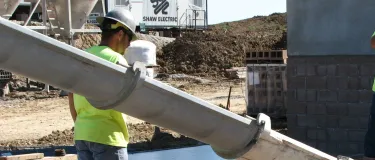While many people embrace the arrival of summer and all its outdoor recreation, opportunities for relaxation, and fun—for even the most experienced of contractors, the onset of summer weather isn’t necessarily a time to look forward to. This is because placing and finishing concrete during the summer can be extremely challenging. As air temperatures climb, concrete temperatures rise, resulting in a faster rate of cement hydration and set times, a rapid loss of water and slump, and undesirable workability. To make placements even more demanding, using water to control the workability and set increases the water/cement ratio, which can result in lower strengths and serious durability problems.
While elevated temperature concerns are more common in the summer, there are additional associated environmental conditions that can have deleterious effects on concrete performance problems at any time of the year, especially in arid climates. ACI (American Concrete Institute) 305 defines these hot-weather factors as any combination of high ambient temperature, low relative humidity, and high wind speed. High solar radiation is also problematic.
When mixing, transporting, placing, and curing concrete in adverse hot-weather situations, producers and contractors can improve the plastic-state properties of the mix and reduce strength loss, shrinkage, cracking, and other problems by implementing a variety of preventive measures and best practices.
Adjust the Concrete Mixture
A key first step in a successful hot-weather concrete placement is the selection and proportioning of materials to achieve the best mix for controlling performance properties at elevated temperatures.
To compensate for increased water demand and offset accelerating effects of high temperatures, modify the concrete mix formulation with the addition of admixtures that meet ASTM C 494, Type D requirements. These may include mid-range and high-range water reducers, set retarders, and/or air-entraining admixtures. Extended set control admixtures in varying proportions may also be used for long-haul material deliveries or in extremely high temperatures.
If the concrete seems a little dry at the jobsite, increase the dosage of admixtures and limit the addition of water to manage workability, set time, and other characteristics. Exceeding the quantity of mixing water allowed for the concrete will decrease the long-term strength, durability, and other performance properties of the final product.
As work progresses, continuously monitor the concrete temperature and adjust the dosages of water-reducing and set-retarding admixtures as needed to improve workability and achieve a uniform time of setting. Dosages of air-entraining admixtures may also need to increase in weather conditions with elevated temperatures.
Formulating the mix with high volumes of slag, fly ash, and/or other pozzolans as partial replacements of Portland cement can also significantly improve the workability of the concrete and slow its set. The greater the percentage of slag and/or fly ash in the mix, the greater the reduction in the rate of hydration and concrete temperature, which will improve moisture availability, strength gain, and durability performance. The supplementary cementitious materials (SCMs) are also less adversely affected by elevated-temperature curing. Designed with high volumes of SCMs in the mixes, Holcim’s portfolio of ECOPact™ low-carbon concrete products are an ideal solution to overcoming the challenges of working in hot weather conditions.
Keep Everything Cool
To increase the quality of concrete, the temperature of the concrete should be kept as low as feasible. The lower the temperature, the slower the set and the more the water is available in the mix to fully hydrate the cement particles. Concrete that is being placed at 60 °F will set slower but will have a higher ultimate strength compared to concrete that has been placed at 80 °F.
When the temperature of freshly mixed concrete approaches 77 °F, adverse site conditions can impact the quality of concrete. At that point, mitigation measures need to be taken to cool down the concrete as much as possible. This can be accomplished in a variety of ways.
The most efficient method is to cool the aggregates, which account for 60 to 75 percent of the volume of the concrete. As a rule of thumb, a one-degree rise in the aggregate will result in a one-degree rise in the concrete temperature. Preventive actions to take include storing the aggregates in the shade, sprinkling water on stockpiles, and spraying the aggregates with cool air shortly before batching. The effect of hot cement on concrete temperature is only minimal.
In practice, mixing water has the largest impact on reducing concrete temperature and controlling it is easier than controlling the temperature of the other ingredients. Chilled water can reduce the concrete temperature by up to 10 °F and ice can reduce the temperature by up to 20 °F. For greater reductions in temperature, liquid nitrogen can be injected into concrete mixers.
Before pouring the concrete, contractors should dampen the subgrade, forms, and reinforcement with cool water and avoid excessive water ponding. Windbreaks, sunscreens, and mist fogging should also be deployed to avoid rapid moisture loss from the surface of the freshly placed concrete.
Maintain Proper Curing Practices
Plans must include active protection and curing strategies to provide satisfactory and uninterrupted moisture content in the concrete for at least three days. It is of paramount importance to account for rapid moisture loss during hot weather conditions, as it is essential that all surfaces be kept continuously moist. The longer the concrete is cured, the better the durability will be. Drying, even intermittently, can produce shrinkage cracks, thermal cracks, and a considerable loss in the strength of the surface layer.
Deploy techniques to apply a continuous sprinkling of water over the concrete as soon as finishing operations are complete. Keep the surface moist by applying saturated wet coverings, such as burlap, and cover them with plastic sheeting. Avoid wind and sunrays throughout the curing process, as water evaporating too quickly from the concrete surface can severely compromise the finished product.
Concrete is tough, but it is not invincible. The application of a combination cure and seal products (ASTM 1319) late in the season will enhance durability, resistance to deicing salts, and long-term aesthetics. It will also lock out moisture intrusion, thereby lessening damage that comes from what will inevitably follow hot summer temperatures—winter’s freezing and thawing.

We Are Here to Help
Contact your sales representative or submit an inquiry below to learn more about the ways Holcim can help you succeed with your next hot-weather concreting project. These knowledgeable field specialists can share a wealth of additional information on best practices to ensure outstanding results and long-term customer satisfaction.






